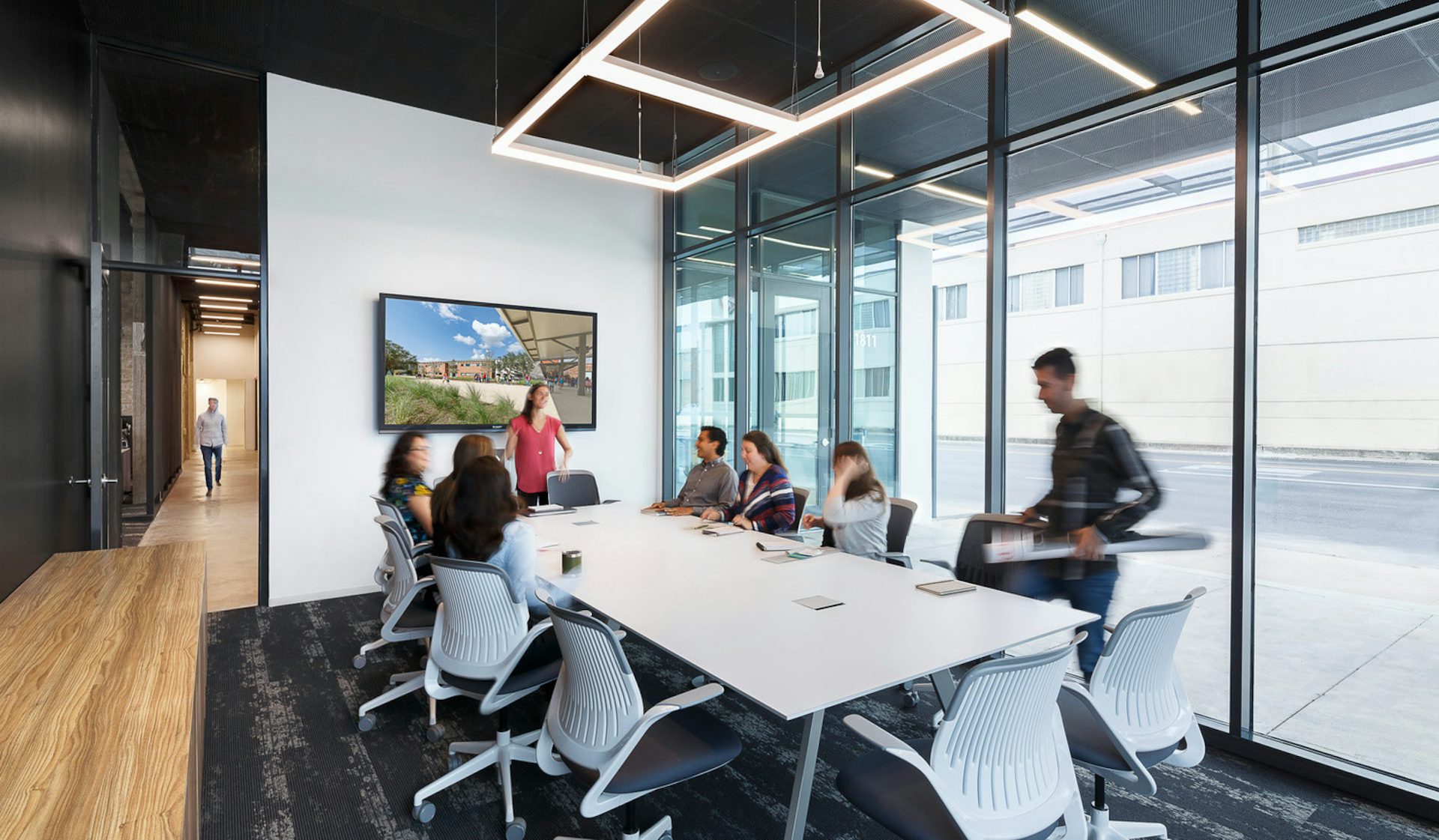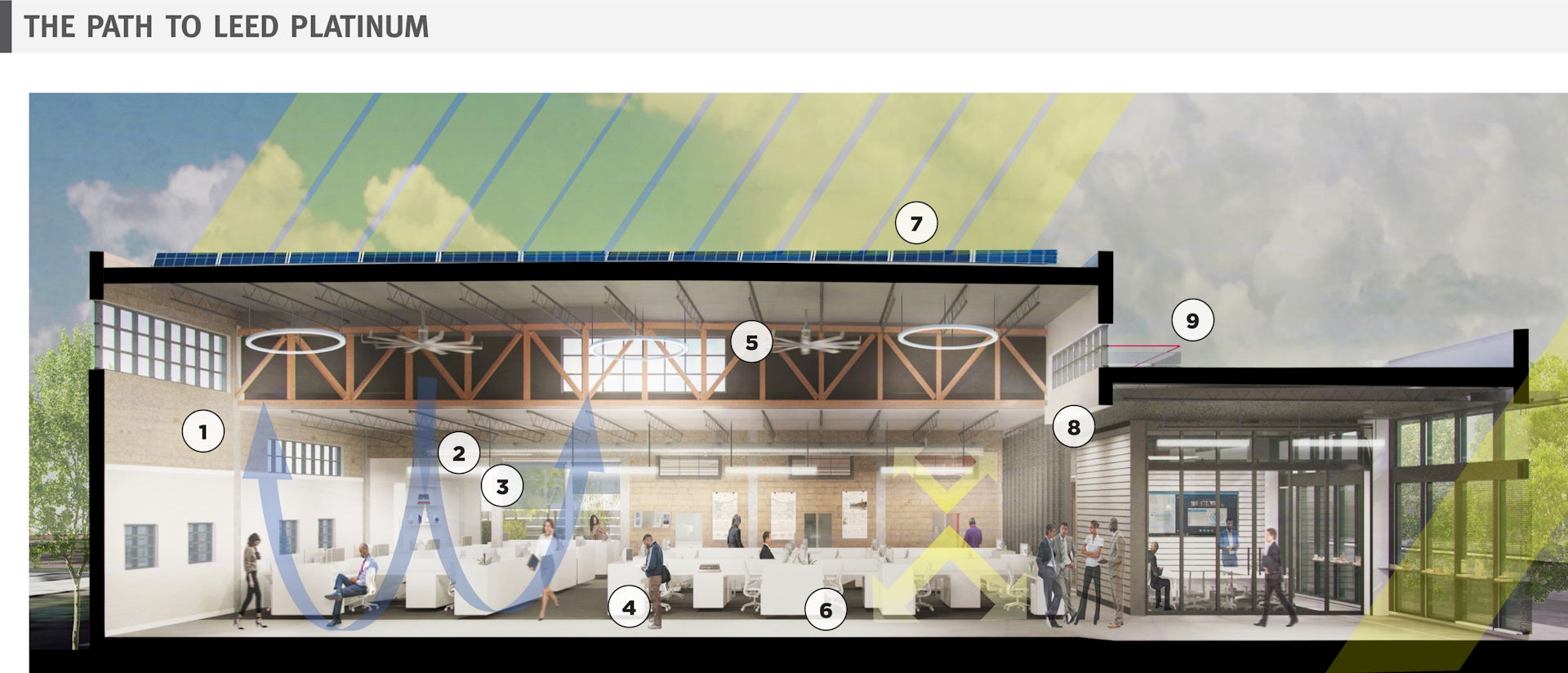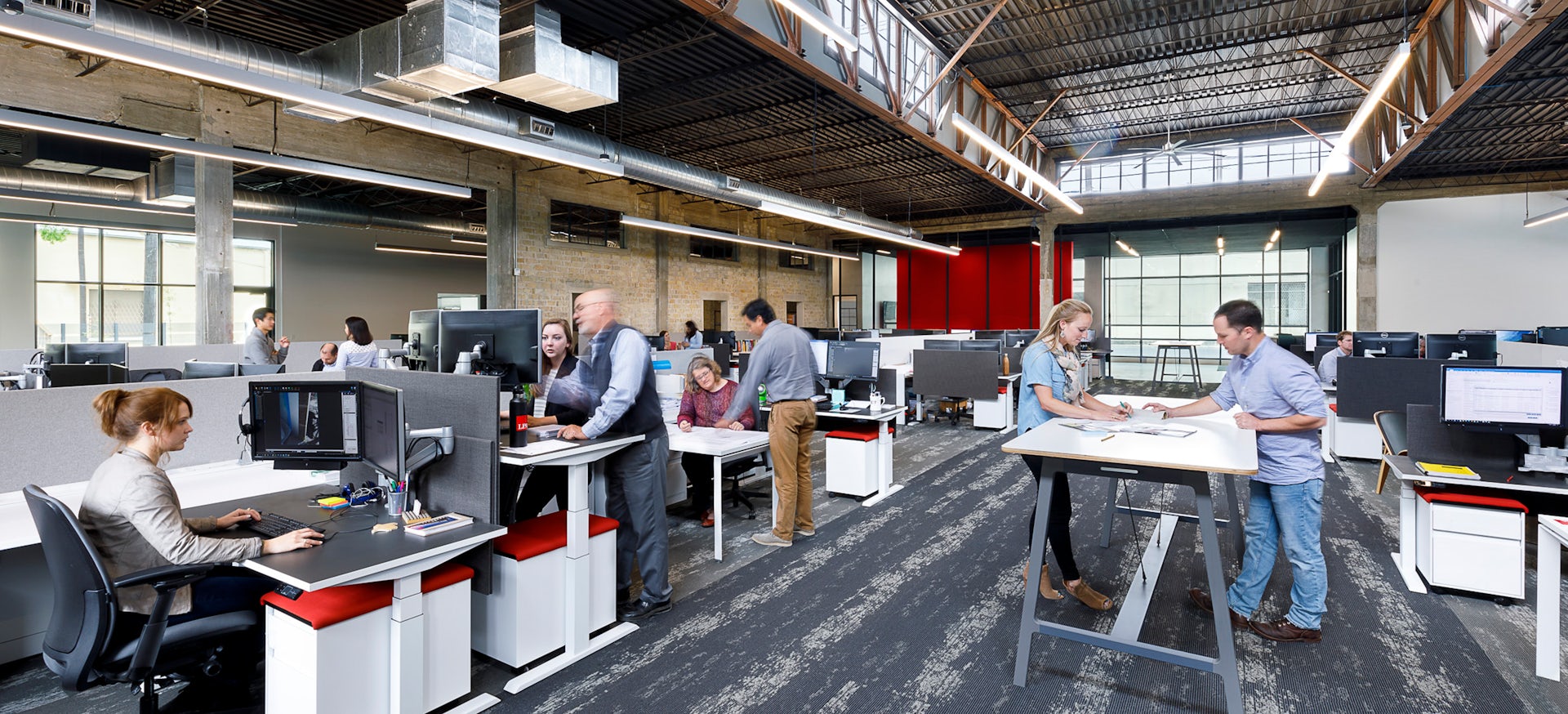When LPA identified an abandoned retail space in the up-and-coming Southtown district as the new home of its San Antonio studio, it gave designers an opportunity to put their principles and process to work on their own space. Beyond creating a dynamic work environment, the design team, which has deep roots in the city, wanted the office to be used as a tool to demonstrate the value of repositioning an underutilized building into a collaborative, energy efficient work environment.
The 10,300-square-foot building is located on Alamo Street, a main artery connection from the traditionally industrial Southtown to central San Antonio. The building was built in the 1950s, although the final design would include a commercial structure built in the early 1900s.
A Study in Adaptive Reuse
A long-vacant retail space in San Antonio was redeveloped into a modern, LEED Platinum workplace that boosts a revitalized neighborhood.

“This is a historic area that until recently was left behind in the revitalization of the city,” says LPA Principal Mark Oppelt. “We all felt a strong responsibility to design a building that would help the neighborhood.” (Last October Oppelt received the AIA San Antonio’s Legacy Award, recognizing “a lifetime of distinguished leadership and dedication to architecture, the profession and the community.”)
The team approached the new studio like any other client-driven project. The research-based design process started with an effort to learn more about how the team worked—and how they might work better and benefit more from the experience.
“What is really inspiring about this project is that we really need to do more with our existing buildings. It’s great to see such a well-considered and well-crafted project on this part of a thoroughfare.” - COTE Jury

Research included a post occupancy evaluation of LPA’s San Jose studio, conducted in collaboration with the University of California’s Berkley’s Center for the Built Environment. This study analyzed a variety of workplace features including lighting, acoustics, thermal comfort and furniture.
Next was research of the existing space, including a four-day observation study to collect data on how spaces were utilized. The employees also participated in an online workplace survey, providing the design team with clear direction on how the staff function and their priorities, from where they liked to eat lunch to the lack of informal meeting spaces.
Throughout the process, the design team utilized an integrated approach, including LPA engineers, interior designers and landscape architects. Energy modeling was used at multiple stages to analyze the building and studies were conducted of the different materials and their impact on users.

The final design left much of the existing warehouse structure untouched. The façade of the older commercial structure was stabilized to retain the streetscape and screen a surface parking lot. Open landscaped spaces were created by the design and a collaborative space opens to the street, putting the firm’s work on display.
An “Integrated fold” announces the entry and leads visitors from the parking plaza to the reception area and community room. The fold brands the space with a physical display of the firms integrated practice, in addition to providing exterior solar protection and acoustic treatment. Throughout the space, the old and new are contrasted, including the exposed original stone wall and ceiling.
“It’s a very open, comfortable space with plenty of natural light,” says LPA San Antonio Studio Director Sara Flowers. “You feel connected to the roots of the building, while still feeling like you are in a modern, collaborative environment.”

Sustainable features are fully exposed and on display, promoting the firm’s process and focus on performance. The project earned LEED Platinum, with help of a 63.7-kilowatt photovoltaic (PV) system, which includes a solar canopy over parking stalls. The PV system offsets more than 50 percent of the total energy use. Other sustainable features include 100 percent LED lighting fixtures with controls, energy monitoring and low-impact site development techniques.
This project promotes water efficiency through the use of native plants in the landscape and low impact development features – acting as a model to the community about how a water efficient landscape can be beautiful and beneficial to treating storm water on site. Conservation measures include low-flow plumbing fixtures, efficient water heaters and grading strategies provide water to vegetated bioswale. The retrofit mitigates storm water runoff by capturing and treating it on-site using a combination of a cistern to capture rooftop runoff and bioretention areas to capture and treat parking lot runoff.

The project came in under budget with a cost of $85.30 per square foot, including furniture, fixtures and equipment. It also had an influence far beyond the studio. The renovation was a pilot project for The San Antonio River Authority’s Low Impact Development (LID) initiative and became a model for adaptive re-use in the city. In many ways, the project made a statement in San Antonio, earning the Best Green Building award from the San Antonio Business Journal and the City of San Antonio’s SA Tomorrow Sustainability Award in the Retrofit Commercial Office category. In October, the studio earned a COTE Award, the industry’s top honor for sustainable design, from AIA San Antonio chapter.

“It’s a very open, comfortable space with plenty of natural light. You feel connected to the roots of the building, while still feeling like you are in a modern, collaborative environment.” - Sara Flowers, LPA San Antonio Studio Director
“This is a great example of how to do excellent adaptive reuse,” jurors said. “What is really inspiring about this project is that we really need to do more with our existing buildings. It’s great to see such a well-considered and well-crafted project on this part of a thoroughfare.”

1. Existing structure, walls and openings 100% re-purposed
2. LED technology is used for 90% of the fixtures with the remaining 10% high-efficiency fluorescents
3. Lighting design reduces the space’s LPD by 40% from the baseline exceeding the 2030 Challenge LPDS for interiors by 61%
4. System furniture with 70% recycled content
5. Efficient ceiling fans promote air circulation in the large volume studio
6. Carpet tiles incorporate 68% recycled content, 30% post-consumer
7. Photovolatic solar panels that produce 50% of the energy necessary to run the office
8. Efficient HVAC ducts designed coordinated with ceiling fans
9. New HVAC units 30% better than ASHRAE 90.1















